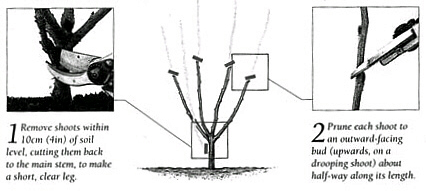An ideal fruit for the small garden – gooseberry bushes are easy to grow, produce a large amount of fruit for their size and will tolerate partial shade conditions.
They are self-fertile, so one bush can be grown on its own. Gooseberry bushes are also well able to withstand harsher conditions (both temperature and wind) than many other fruits. This makes them a good choice for cooler areas.
Usually grown in the form of a small bush, they can be trained to any shape and are especially recommended for pot culture.
Growing Conditions
Plants will tolerate partial shade, but a sunny site with good movement of air gives higher yields. Powdery mildew and frost injury to blossoms can be problems in sites with poor air movement.
Gooseberry plants tolerate a wide range of soils, except those that are waterlogged. However, plants grow best in a cool, moist but well-drained, rich clay loam. On sandy soils, pay close attention to mulching and watering. Gooseberry bushes need the soil to be kept moist, especially when the fruit is being formed. In dry periods during June to August, water them to keep the soil moist.
Put a layer of organic material to act as a mulch around (but not touching) the main stem each spring. Where no organic material is available, incorporate a couple of handfuls into the top soil around the bush and cover the soil with bark chipping or similar to prevent the growth of weeds. A couple of handfuls of bone meal applied again September should be all that is needed.
Planting
Early spring planting is preferred over fall planting.
1) Plant bare-rooted bushes by spreading their roots out in the hole and covering with well-conditioned soil. Do not let the roots dry out during planting.
2) Firm the soil down around the roots.
3) With container-grown bushes, keep the surface of the root ball compost level with the surrounding soil surface. Space cordons 30cm-45cm (12in to 18in) apart and bushes at least 1.2m (4ft) apart to allow access for picking.
4) Keep plants well watered until established, and cover the soil around them with a 5cm to 7.5cm (2 to 3 inches) thick mulch of compost or bark.
5) Prune branches to a length of 10 to 15 cm (4 to 6 inches) at planting time. This stimulates new growth. With fall planting, this pruning should be delayed until spring. Prune all other branches to between a third and a half of their original length, cutting to an outward facing bud.
6) Net during June and July to protect fruit from birds.
Harvesting
Most varieties of Gooseberry bush produce both cooking and eating gooseberries – those for cooking being harvested earlier than those for eating.
In order to encourage the best berries, pick about 10% of the fruit in mid-May time when they are pea-sized, these can be used for cooking. This will encourage the remaining fruits to become larger.
When the gooseberries look ready for harvest in July time, first pick those fruits which are shaded at the bottom and in the middle of the bush – these will be the first to stop improving. Leave the fruits on the outer edges of the bush to be picked a week or so later.
Propagation
Gooseberries are relatively easy to propagate and there are two methods. Layering and Cuttings
General Pruning Care
Prune the bushes in February each year. Keep the center of the bush clear of most growth by cutting out any weak or dead branches. On the outside of the bush, young growth should be left untouched, older and longer side shoots should be cut back to within 2cm (1 inch) of their base. The aim is to achieve a wine glass shape with the center of the bush reasonably clear of growth.
Winter pruning helps to form a balanced branch structure and keeps the center of the bush open to make picking easier. Mildew disease is also reduced if air circulation is encouraged.
First Year Pruning
In winter after the first full season of growth:
1) Remove any shoots less than 10cm (4in) above the soil cutting back to the main stem.
2) Prune all other shoots to about half their length above and outward facing bud.
3) Prune out any shoots that are growing into the center of the bush, and cut back leaders by one-third.

Second Year Pruning – In winter:
1) Shorten by half new leading shoot on existing branches.
2) Select up to six other well placed, strong shoots and shorten these by half.
3) Cut any weak sides hoots back to one bud to encourage stronger growth

Subsequent Yearly Pruning – In winter:
1) Prune to one bud all side shoots that grew from the main framework branches in the last growing season.
2) Trim off 5–10cm (2–4in) from the leader shoots of the main branches to promote healthy growth if there is there is still plenty of room for growth otherwise cut back further.
3) Remove any old or diseased branches.
4) Remove low growing branches as any fruit on these will be vulnerable to pests and rodents.
